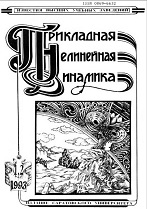|
This article is cited in 18 scientific papers (total in 18 papers)
REVIEWS OF ACTUAL PROBLEMS OF NONLINEAR DYNAMICS
Nonlinear dynamical models of neurons: Review
A. S. Dmitrichev, D. V. Kasatkin, V. V. Klinshov, S. Yu. Kirillov, O. V. Maslennikov, D. S. Shapin, V. I. Nekorkin
Institute of Applied Physics, Russian Academy of Sciences, Nizhny Novgorod
Abstract:
Topic. A review of the basic dynamical models of neural activity is presented and individual features of their behavior are discussed, which can be used as a basis for the subsequent development and construction of various configurations of neural networks. The work contains both new original results and generalization of already known ones published earlier in different journals. Aim is to familiarize the reader with the basic dynamical properties of neurons, such as the existence of a rest state and the generation of the action potential; to outline the dynamical mechanisms underlying these properties which are used in the development of neural models with various levels of detailing. Investigated models. From the mathematical point of view, neuron models are divided into two classes. The first class is represented by models with continuous time described by ordinary differential equations. The section devoted to continuous-time models starts from the most detailed Hodgkin–Huxley model, which is a canonical model for neural activity in nonlinear dynamics. Further we describe simplified models, such as a two-dimensional model of Morris–Lecar for spiking and a three-dimensional model of Hindmarsh–Rose for bursting. The FitzHugh–Nagumo model is described in detail, and detailed bifurcation analysis is presented. We also present models for neurons with specific properties, namely a neuron with afterdepolarization and an inferior olives neuron. The last and the simplest model is the «integrate-fire» model. The second class of neural models are systems with discrete time represented by discrete maps. Such models have recently gained increasing popularity due to the richness of the demonstrated dynamics and the ease of numerical simulations. We describe such models as the Chialvo model, the Izhikevich model, the Rulkov model, and the Courbage–Nekorkin model. Results. The basic physical principles underlying the construction of mathematical models of neural activity, based on ion transport, are outlined. Using the FitzHugh–Nagumo model as an example, the main properties and mechanisms of the emergence of multithreshold excitation regimes in neurons are described. The mechanism of formation of burst oscillations in the Hindmarsh-Rose model is outlined. A dynamic mechanism for temporal decline of the excitation threshold and the emergence of periodic oscillations in a neuron with afterdepolarization are described. The formation of (Ca2+)- and (Na2+)-dependent spikes in inferior olive neurons is described. Dynamic mechanisms of formation of the major regular and chaotic regimes of neural activity in discrete models of Chialvo, Izhikevich, Rulkov and Courbage–Nekorkin are described. Discussion. In the Conclusion we briefly summarize the content of the survey.
Keywords:
dynamical systems, neurons, bifurcations.
Received: 01.06.2018
Citation:
A. S. Dmitrichev, D. V. Kasatkin, V. V. Klinshov, S. Yu. Kirillov, O. V. Maslennikov, D. S. Shapin, V. I. Nekorkin, “Nonlinear dynamical models of neurons: Review”, Izvestiya VUZ. Applied Nonlinear Dynamics, 26:4 (2018), 5–58
Linking options:
https://www.mathnet.ru/eng/ivp88 https://www.mathnet.ru/eng/ivp/v26/i4/p5
|

| Statistics & downloads: |
| Abstract page: | 597 | | Full-text PDF : | 824 |
|




 Contact us:
Contact us: Terms of Use
Terms of Use
 Registration to the website
Registration to the website Logotypes
Logotypes








 Citation in format
Citation in format 
